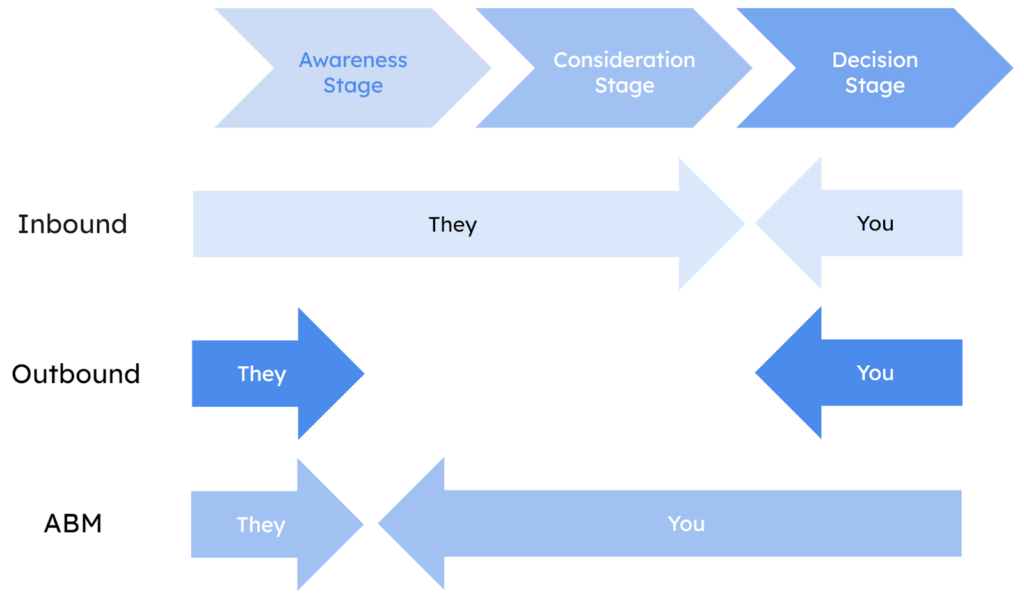
It is critical to select the best digital marketing plan if you run a firm in the SaaS industry. That’s why an increasing number of businesses in the industry rely heavily on inbound strategies for customer acquisition and maintenance.
Instead of using traditional outbound marketing methods that force your firm upon consumers, inbound marketing is a better fit for a SaaS company because it is centered on drawing in and keeping the attention of customers.
Following the steps in this tutorial will get you up to speed on all you need to know to generate marketing-qualified leads and fill your inbound funnel.
What Is Inbound Marketing?
The goal of inbound marketing is to attract qualified leads and customers by creating and distributing information that is interesting, useful, or entertaining to them. Blog postings, search engine optimization (SEO), social media, and other strategies are utilized to reach a wide range of potential customers and convert them into leads.
What Is The Difference Between Inbound Marketing and Outbound Marketing?

All forms of “intrusive” advertising that are not integrated into the customer’s journey are considered outbound marketing. Ads are positioned tactically in places where target audiences are likely to be present. Advertisements are a typical example of this, and they pop up during most of the videos you watch on Youtube.
There is more “empathy” in inbound marketing. It entails giving your customers a lot of value while encouraging them to interact with your business in a way that seems natural and not intrusive. The goal is to entice viewers. Blog entries, newsletters, and other similar formats are common examples.
Over time, we gained access to resources that allowed us to prevent unwanted commercial communications from reaching us (adblock, etc.). Because of this, the “annoying” advertising strategies have been phased out, and the outbound marketing conversion rate has plummeted. The influx of inbound traffic is gradually displacing the outbound.
Why Is Inbound SaaS Marketing Important?
In the SaaS marketing funnel, inbound marketing helps build credibility for the software company’s brand and produce leads at a cheap cost with high perceived value for the buyer.
Inbound marketing is less expensive than typical outbound tactics since it focuses on identifying and alleviating the problems your ideal customers are having.
Aligning your digital presence with what your target audience cares about can make your company a go-to resource on its path to “better,” generating buzz and generating leads that will increase your return on investment.
A superpower in today’s world is the ability to get people to click on stuff online. The ability to do this naturally (at no cost) is very valuable for a startup.
For this reason, inbound marketing methods are crucial for the modern marketer. Inbound is all about giving your customers more agency rather than the interruption-based marketing that gives enterprises all the power.
How Do You Put Inbound Marketing For SaaS Into Action?
In three steps, you set up SaaS inbound marketing.
- Content Creation
- Content promotion
- Content optimization.
At each of these stages, you can learn more about what you must do to make absolutely sure your inbound marketing works well. So, let’s get to the good stuff in this SaaS sandwich.
Content Creation
The first step in your growth-focused inbound SaaS content marketing strategy is to create the content that is so important. But it’s important not to make content based on what “feels” right and instead make content based on what is right.
You can do this by doing a lot of research to make sure you’re making content that people need and are looking for. This will give your content the best chance of getting in front of the right eyes.
User Research
Create user personas based on their responsibilities, jobs, needs, pain points, missions, values, and past experiences.
Once you know your user, you may tailor your material to them. Topics, types, language, media, distribution route, length, etc.
Search Keywords
Next, keywords. This helps your material be found, ranked, and clicked on, especially if you’re blogging or constructing landing pages.
Competitor Research
Use a SWOT analysis to conduct competitive research. Examine what your competitors are doing well with their content, what they’re not, the potential to beat them, and threats if you do.
Trend analysis
We’re almost done with the research. This is crucial to your niche. What channels may your material go viral? Your competitive analysis and user research will show you which channels to focus on, but developing channels may also offer opportunities.
Medium Research
What content fits your potential users? This relies on their demographics, which you’ll have researched before. This will direct your content creation and change your marketing team structure.
Content Development
After your research, you can finally now start creating content.
Promotion of Content
If you’ve done your research well, you should already know where your content will get the most attention. Instead of talking about what these promotion channels can do for you, we’ll show you how to get the most out of them. If you use these tips to promote your content, you’ll reach more people than ever before.
“Content is a 50:50 split between creation and distribution.”
—Kirsty quote.
SEO
SEO tops our content promotion list, naturally. We’re biased, though. It is said that if Content is Kind then SEO is Queen and there is no way you can promote your content without some proper search engine optimization techniques.

Social Networking
Social Media can help distribute B2B content. Make sure your social copy and posts speak to each channel’s demographics.
Email Marketing
Hyper-segmentation is email’s distribution secret. It’s pointless to send the same content to 1000+ people on a generic email list. Humans have likes, dislikes, and experiences that form their mailbox needs. That’s why getting your hands on some high-performing email marketing strategies is a need of the hour.
Marketing-by-referral
Who are your strongest advocates? Users!
They’ll gush about your business and product. Don’t abandon them. Create distinctive, shareable content. Consider email templates or Whatsapp snippets.
Influencers
Influence-related. Influencers are up next. Every specialty has influencers. No matter how niche your product is, there is a social media audience for it. Find out more about them. You can accomplish this by searching for individuals underneath keywords or hashtags, however, if you’re handling social well, there’s a strong chance you already recognize who all these folks are.
Content Optimization
Even though your content is great, it could always be better. Optimization is the last thing you need to think about for your inbound marketing playbook. Always look for ways to improve your content, like the ones we’ve talked about so far. This will bring in more leads and lower the number of people who drop out of the sales process.
What does an SEO strategy for content look like? WE are glad you asked. Here is what it consists of:
KPIs
KPIs show you’re on track to meet monthly, quarterly, and yearly goals. Benchmark those KPIs against past data sets to ensure you’re setting realistic targets for your content strategy.
Inbound marketing KPIs include:
| Primary | Secondary |
| MQLs or product activations | Qualified Lead generation or signups |
| New MRR / Pipeline generated | CTR |
| Newsletter Signups | |
| Impressions | |
| Social Media Growth | |
| Brand searches | |
| Time on page | |
| Exit rate | |
| New visits | |
| Visits by source | |
| Blog subscribers & views | |
| Inbound links | |
| Email opens and click-throughs | |
| Keyword rankings | |
| SaaS SEO KPIs |
Red Flags
Content optimization isn’t always measured. Instead, watch for red flags.
Set up tools and processes to inform you when content fails.
NPS/Polls
Ask your audience how they view your brand and content.NPS surveys evaluate how your brand is viewed and whether you’re improving.
5+ Inbound Marketing Tips for SaaS
Free Trials Boost Sales
For a SaaS company, free trials are often crucial to attracting new clients. Free trials can create new leads and convert shoppers quickly, like free returns.
For free trials, many SaaS marketing initiatives demand a credit card. After the trial, your company can instantly sell the product.
Your free trial can show potential clients your whole software. Your organization may lock certain features to attract customers.
Slow Isn’t Always Best
In a SaaS marketing effort, it’s more crucial to create leads quickly than to wait for results.
Inbound marketing offers reliable and consistent outcomes for SaaS companies. Outbound marketing delivers inconsistent and unpredictable results, reducing ROI (ROI).
Why does inbound work?
It offers customized targeted content. A subscriber to your email newsletter may receive communications about the software they investigated on your site.
SEO is vital
When selling software, your marketing methods should attract new consumers and persuade them why buying your products is a good investment.
You can’t demonstrate to prospective clients the value of your product if they don’t know your brand. That’s where SEO strategies come in. SEO helps your business get recognized on search engines.
Become an Industry leader
Selling software isn’t simple, especially with severe competition. Inbound marketing methods should highlight your competitive edge and USPs.
Increase Sales Through Social Media
Inbound marketing must include social media. LinkedIn, Facebook, and Twitter help you reach new clients and promote your brand and services. It is crucial for SaaS companies to know how to create efficient Social Media Funnels to expand beyond social media to reach their target market.
Make Your SaaS Sellable
Producing top-tier software that sells itself is the first and foremost thing you should focus on when developing SaaS inbound marketing strategies.
Your company’s departments must work together to thrive with inbound marketing. Try to prioritize fixing an irritating bug in your program with your development team.
Bottom Line
Making wise decisions is the general rule. When it comes to your SaaS marketing approach, don’t let anything cloud your judgment.
Your endeavors should lead to profitability and revenue-centricity. However, keep in mind that everything you do must be focused on your users.
SaaS marketing varies by the firm; what works for one may not work for another, and it’s all about trial and error.
The post Inbound SaaS Marketing: Everything You Should Know About It appeared first on noupe.